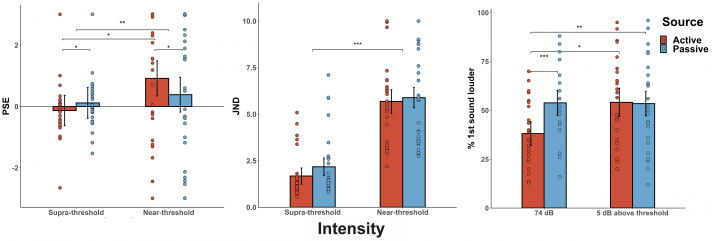The paper entitled Self-generation and sound intensity interactively modulate perceptual bias, but not perceptual sensitivity, by Paraskevoudi Nadia and SanMiguel Iria, has been published in the journal Scientific Reports.
This paper is the outcome of a scientific study of the research line Predictive processes in Motor-Sensory interactions of the Brainlab that focuses on mechanisms underlying sensory processing for self-produced auditory stimulation and its perceptual correlates. This study tapped into an apparent discrepancy in the literature concerning the perceptual processing of self-generated stimuli. While traditionally studies have shown attenuated perception for supra-threshold sounds produced by our own actions, there is also preliminary evidence of the opposite effect, that is enhanced perceptual processing, when the sensory consequences of a motor act are of low intensity. Additionally, the studies conducted so far have not systematically assessed the effects of self-generation (and their interaction with stimulus intensity) on the different perceptual measures.
Here, Paraskevoudi and SanMiguel present a pre-registered study with a priori power estimations that utilized a wide range of intensities to assess whether self-generation (self- and externally-generated) and stimulus intensity (supra- and near-threshold) interactively modulate detection ability and loudness perception. While detection ability (i.e., sensitivity) did not differ between self-produced and passively presented sounds, the results of the discrimination task showed a significant interaction between self-generation and intensity on perceptual bias (i.e., Point of Subjective Equality) that replicates and extends previous work by showing that perceived intensity is reduced for self-generated sounds when they are presented at supra-threshold intensities, but enhanced when presented at near-threshold intensities. These findings provide empirical support to recent theories on how predictions scaffold perception by showing that self-generation interacts with the noise of the sensory outcome in driving perceptual processing, with this interaction being reflected in a shift in perceptual bias, rather than perceptual sensitivity.
The full abstract reads as follows:
The ability to distinguish self-generated stimuli from those caused by external sources is critical for all behaving organisms. Although many studies point to a sensory attenuation of self-generated stimuli, recent evidence suggests that motor actions can result in either attenuated or enhanced perceptual processing depending on the environmental context (i.e., stimulus intensity). The present study employed 2-AFC sound detection and loudness discrimination tasks to test whether sound source (self- or externally-generated) and stimulus intensity (supra- or near-threshold) interactively modulate detection ability and loudness perception. Self-generation did not affect detection and discrimination sensitivity (i.e., detection thresholds and Just Noticeable Difference, respectively). However, in the discrimination task, we observed a significant interaction between self-generation and intensity on perceptual bias (i.e. Point of Subjective Equality). Supra-threshold self-generated sounds were perceived softer than externally-generated ones, while at near-threshold intensities self-generated sounds were perceived louder than externally-generated ones. Our findings provide empirical support to recent theories on how predictions and signal intensity modulate perceptual processing, pointing to interactive effects of intensity and self-generation that seem to be driven by a biased estimate of perceived loudness, rather by changes in detection and discrimination sensitivity.
Reference:
Paraskevoudi, N., SanMiguel, I. Self-generation and sound intensity interactively modulate perceptual bias, but not perceptual sensitivity. Sci Rep 11, 17103 (2021).
Permanent doi: https://doi.org/10.1038/s41598-021-96346-z.
All data and analysis scripts are available at the Open Science Framework: https://osf.io/ypajr/.



